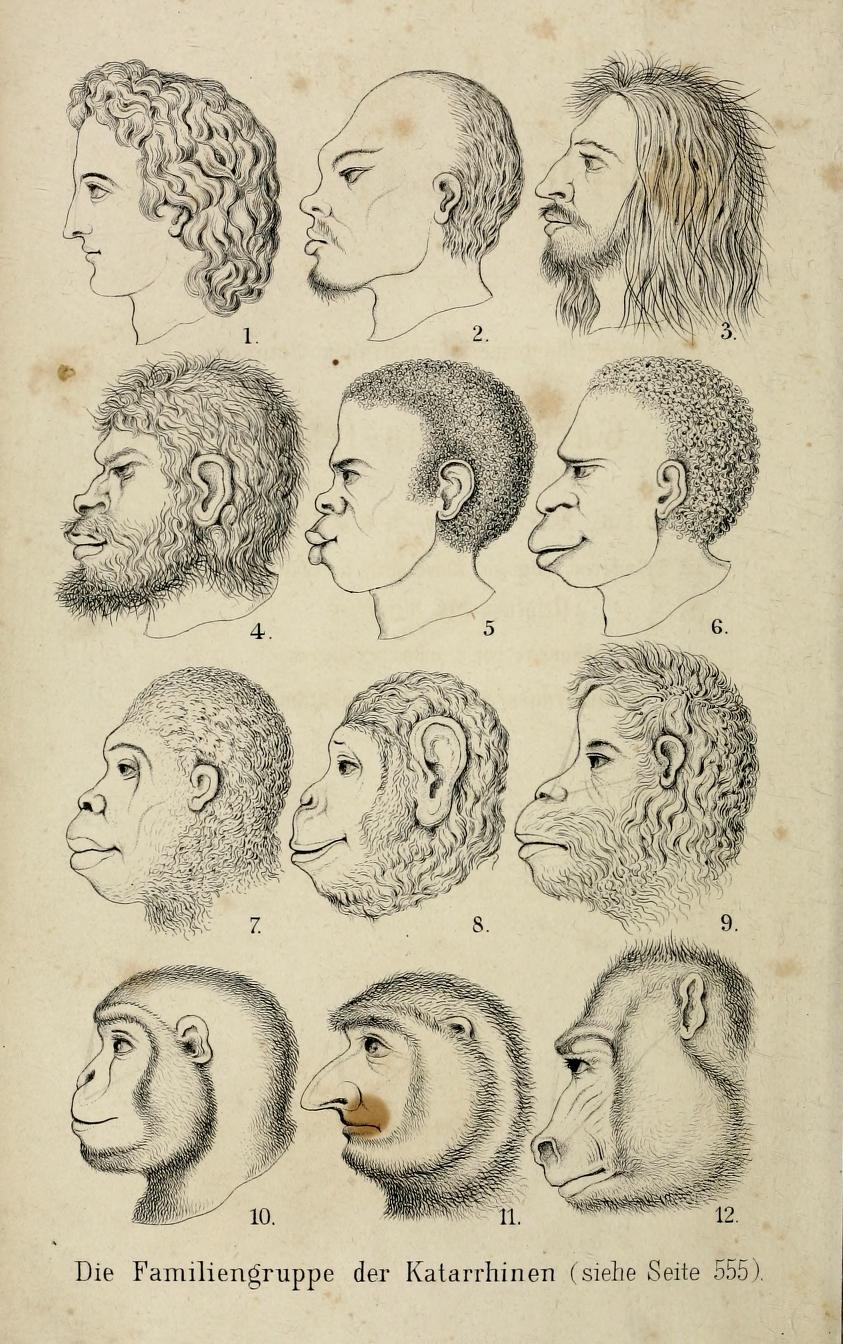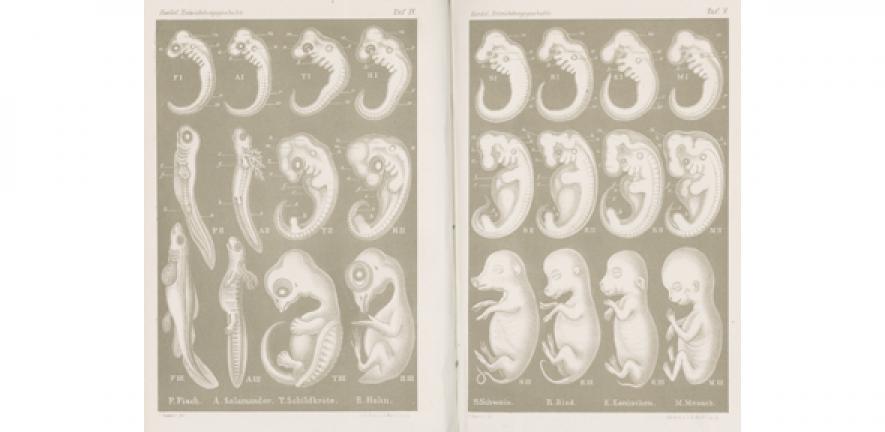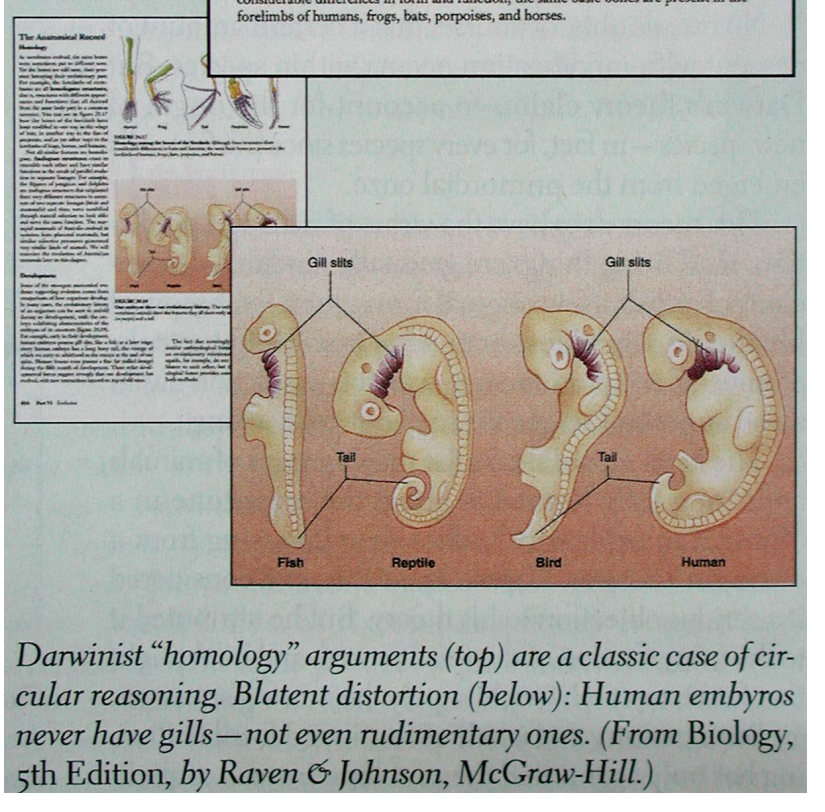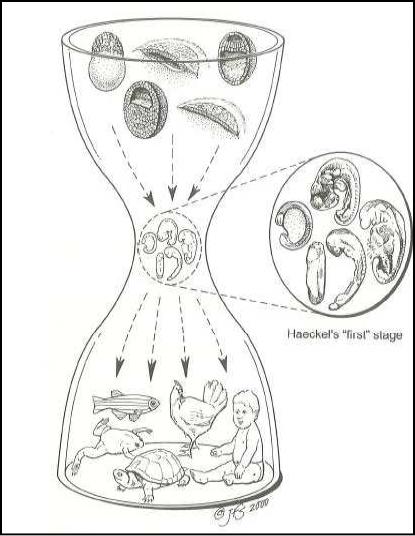It is strange that Haeckel has come up again, so let us first understand just how manipulative and dishonest he was in his books that popularised Evolutionism in Germany and elsewhere. As a start, here is his infamous drawing of heads of men and other primates:

This was a time when photography was not ubiquitous, where trips to Zoos and Museums were relatively rare and so “heavy artillery” “facts” in drawings like this from respected scientists, scholars and publishers would have powerful impact.
I just say, failed duty to truth, right reason, prudence [including warrant] and fairness. Likely, though, Haeckel did not see where this sort of racist propaganda would end, in the 1930’s and 40’s.
It is in this context that we should evaluate his similarly artfully distorted comparative illustrations of embryos, intended to support the phrase — he seems to have coined it — ontogeny recapitulates phylogeny . . . the development from zygote retraces evolutionary, body plan level ancestry. (Often, in textbooks up to the turn of the 2,000’s, much was made of what superficially looks like gill filaments.)
Here, the 1874 version (the first was 1868):

Richardson’s comparison [HT: Creation dot com}:

In Jonathan Wells’ Survival of the Fakest, he documents the gill slits distortion, c 2000, from a textbook by a well known publisher:

If memory serves, gill slits was in my HS Bio textbook and was shown in TV documentaries from about 25 – 30 years earlier.
Wells’ commentary is, for cause, stinging:
Darwin thought “by far the strongest single class
of facts in favor of” his theory came from embry-
ology. Darwin was not an embryologist, however,
so he relied on the work of German biologist Ernst
Haeckel, who produced drawings of embryos from
various classes of vertebrates to show that they are
virtually identical in their earliest stages, and become
noticeably different only as they develop. It was this
pattern that Darwin found so convincing.
This may be the most egregious of distor-
tions, since biologists have known for over a cen-
tury that vertebrate embryos never look as similar as
Haeckel drew them. In some cases, Haeckel used
the same woodcut to print embryos that were sup-
posedly from different classes. In others, he doc-
tored his drawings to make the embryos appear
more alike than they really were. Haeckel’s con-
temporaries repeatedly criticized him for these mis-
representations, and charges of fraud abounded in
his lifetime. In 1997, British embryologist Michael
Richardson and an international team of experts
compared Haeckel’s drawings with photographs of
actual vertebrate embryos, demonstrating conclu-
sively that the drawings misrepresent the truth.
The drawings are misleading in another way.
Darwin based his inference of common ancestry on
the belief that the earliest stages of embryo devel-
opment are the most similar. Haeckel’s drawings,
however, entirely omit the earliest stages, which are
much different, and start at a more similar midway
point. Embryologist William Ballard wrote in 1976
that it is “only by semantic tricks and subjective
selection of evidence,” by “bending the facts of
nature,” that one can argue that the early stages of
vertebrates “are more alike than their adults.”
Yet some version of Haeckel’s drawings can
be found in most current biology textbooks. Ste-
phen Jay Gould, one of evolutionary theory’s most
vocal proponents, recently wrote that we should be
“astonished and ashamed by the century of mind-
less recycling that has led to the persistence of these
drawings in a large number, if not a majority, of
modern textbooks.”
This contains a reference to the embryological hourglass issue:

That is, some accept that there is a bottleneck stage but it is not the initial one nor is there strong commonality leading up to it before onward divergence to the fully formed newborn or newly hatched.
We do not need to go into an extensive debate with revisionist side tracks that minimise the significance of Wells’ work to bring the icons issue to public attention, Haeckel’s frauds and/or distortions were important and up to a few years ago had lingering impact. END